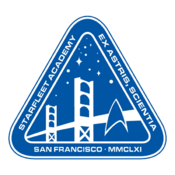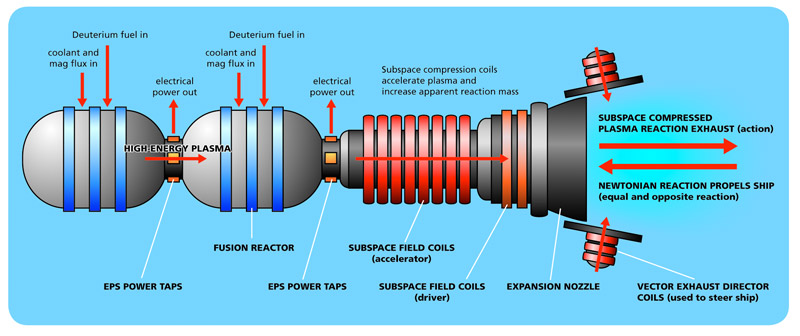Impulse Systems: Difference between revisions
No edit summary |
No edit summary |
||
| Line 1: | Line 1: | ||
[[image:impulsc.jpg]] | [[image:impulsc.jpg|right]] | ||
The principal sublight propulsion of the ship and certain auxiliary power generated operations are handled by the impulse propulsion system (IPS). The total IPS consists of two sets of fusion-powered engines; the main impulse engine and the saucer impulse engines. | The principal sublight propulsion of the ship and certain auxiliary power generated operations are handled by the impulse propulsion system (IPS). The total IPS consists of two sets of fusion-powered engines; the main impulse engine and the saucer impulse engines. | ||
| Line 7: | Line 7: | ||
==IPS Fuel supply== | ==IPS Fuel supply== | ||
[[Image:Fuel.jpg]] | [[Image:Fuel.jpg|left]] | ||
The fuel supplies for the IPS are contained within the primary deuterium tank (PDT) and there are dozens of these tanks distributed around the saucer section. Fuel management routines perform all fuel handling during flight. While the PDT, which also feeds the Warp Propulsions System (WPS), is normally loaded with slush deuterium at a temperature of 13.8K, the cryo reactants stored are in liquid form. The internal volume of each auxiliary tank is 113 cubic meters and each is capable of storing a total of 9.3 metric tones of liquid deuterium. | The fuel supplies for the IPS are contained within the primary deuterium tank (PDT) and there are dozens of these tanks distributed around the saucer section. Fuel management routines perform all fuel handling during flight. While the PDT, which also feeds the Warp Propulsions System (WPS), is normally loaded with slush deuterium at a temperature of 13.8K, the cryo reactants stored are in liquid form. The internal volume of each auxiliary tank is 113 cubic meters and each is capable of storing a total of 9.3 metric tones of liquid deuterium. | ||
| Line 13: | Line 13: | ||
==Impulse Engine Configuration== | ==Impulse Engine Configuration== | ||
[[Image:Impulse.jpg]] | [[Image:Impulse.jpg|left]] | ||
The main impulse engine thrusts along the centerline of the spacecraft. If the ship is capable of separated flight mode. the engine thrust vectors can be adjusted slightly in the Y direction. Four individual impulse engines grouped together form the MIE, and two groups form the saucer impulse engine. A impulse engine consists of three basic components: | The main impulse engine thrusts along the centerline of the spacecraft. If the ship is capable of separated flight mode. the engine thrust vectors can be adjusted slightly in the Y direction. Four individual impulse engines grouped together form the MIE, and two groups form the saucer impulse engine. A impulse engine consists of three basic components: | ||
Revision as of 20:32, 18 August 2004
The principal sublight propulsion of the ship and certain auxiliary power generated operations are handled by the impulse propulsion system (IPS). The total IPS consists of two sets of fusion-powered engines; the main impulse engine and the saucer impulse engines.
During normal docked operations the main impulse engine is the active device, providing the necessary thrust for interplanetary and sublight flight. High speeds are accomplished with help from the auxiliary impulse engines.
IPS Fuel supply
The fuel supplies for the IPS are contained within the primary deuterium tank (PDT) and there are dozens of these tanks distributed around the saucer section. Fuel management routines perform all fuel handling during flight. While the PDT, which also feeds the Warp Propulsions System (WPS), is normally loaded with slush deuterium at a temperature of 13.8K, the cryo reactants stored are in liquid form. The internal volume of each auxiliary tank is 113 cubic meters and each is capable of storing a total of 9.3 metric tones of liquid deuterium.
Impulse Engine Configuration
The main impulse engine thrusts along the centerline of the spacecraft. If the ship is capable of separated flight mode. the engine thrust vectors can be adjusted slightly in the Y direction. Four individual impulse engines grouped together form the MIE, and two groups form the saucer impulse engine. A impulse engine consists of three basic components:
- Impulse reaction chamber (3 per engine).
- Accelerator/generator, driver coil assembly (DCA)
- Vectored exhaust director (VED)
The IRC is an armored sphere six meters in diameter (see picture), designed to contain the energy released in a conventional proton-proton fusion reaction. Slush deuterium from the main cryo tank is heated and fed to interim supply tanks on Deck 9, where the heat energy is removed, bringing the deuterium down to a frozen state as it is formed into pellets.
Pellets can range in size from 0.5 cm to 5 cm. depending on the desired energy output. During propulsion operations, the accelerator is active, raising the velocity of the plasma and passing it on to the third stage, the space-time driver coils.When the impulse engines only have to provide power the accelerator is shut down and the energy is diverted by the EPS to the overall power distribution net. Excess exhaust products can be vented nopropulsively. The combined mode, power generation during propulsion allows the exhaust plasma to pass through, and a portion of the energy is tapped by the MHD system to be sent to the power net. The third stage of the engine is the driver coil assembly. The DCA is 6.5 meters long and 5.8 meters in diameter and consists of a series of six split toroids, each manufactured from cast verterium cortenide 934.Energy from the accelerated plasma when driven through the toroids creates the necessary combined field effect that reduces the apparent mass of the craft at its inner surface, and facilitates the slippage of the continuum past the ship at its outer surface. The final stage is the vectored exhaust director(VED). The VED consists of a series of moveable vanes and channels designed to expel exhaust products in a controlled manner.
| Academy Library |
|---|

|
|---|
 |

